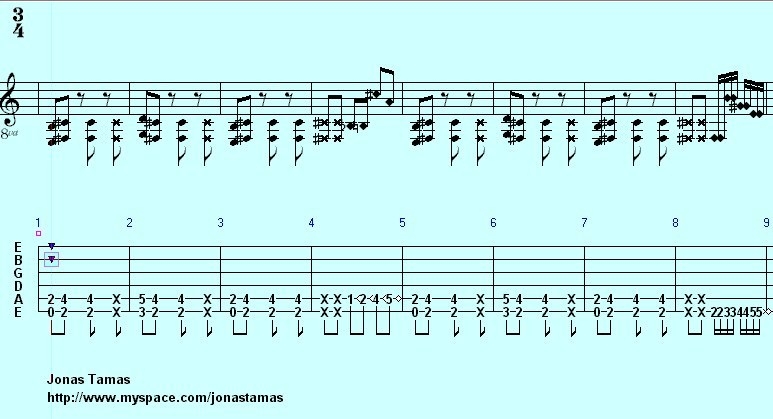Hi fellow guitarists! To begin with, click here to download the sound files of this lesson. The tab for the lesson can be viewed below.
Even the simplest idea can be rekindled with the help of little embellishments. To prove this, I've composed a short riff in F sharp Phrygian, which initially contains only 3 power chords (E, F sharp, G). To make real music out of this, the guitar theme must be brushed up first. In this example, this is achieved by means of string noises and natural harmonics.
To make deliberate string noises (marked with 'xx' signs in the tablature), the first and third (or fourth) finger of your left hand should still be placed on the lowest two strings (F sharp power chord), touching them lightly.

There are tons of natural harmonics on every string. Between the first and the fifth frets, the eight most important ones are at the following positions: 5, 4, 3.1, 2.6, 2.2, 2, 1.7 and 1.4. The fraction (e.g. 3.1) means that this particular natural harmonic can be reached between frets 3 and 4, at 10% of the distance between the two frets (i.e. close to fret 3).
In today's riff, the natural harmonics appear first in the fourth bar. This is the section in the tablature, where you can read '1 2 4 5'. This is meant that you are free to choose here 4 items from the 8 natural harmonics specified above, on string A, while going upwards on the neck. You can hear an example for this series of natural harmonics, in the sound file 'jonastamas_myspace01b.mp3', where the sequence goes 1.8 - 2.2 - 3.1 - 4.
By the way, position 2.2 is really an useful one, because here can you produce the third octave of the corresponding open string (the first two natural harmonic octaves can be found at frets 12 and 7, respectively).
In the eighth bar, there are natural harmonics on the low E string. This time the harmonics are used in a more random way. In this case, the index finger of the left hand simply runs across the area of frets 1-5 rapidly, lightly touching the string, while the right hand picks 8 sixteenths. You can find an example of this run of harmonics in the second part of the file 'jonastamas_myspace01b.mp3'.
Well, we are finished with the embellishment of the riff, now comes a little orchestration. The rhythm section (drum + bass) reinforces the same rhythm, which was introduced in our guitar part. Concerning the drums part, this rhythm is made by the bass drum, while the hi-hats come in fourths, the snare drum at the start of every two bars, and the crash every four bars. The bass guitar plays the root of the corresponding power chords.
The keyboards are recorded separately in the third part of the file 'jonastamas_myspace01b.mp3'. The main theme uses the notes of the F sharp phrygian dominant scale, and at the end of the theme (bar 4), a C major chord is played (the note C is the tritone of the riff's key tone). There is a second keyboard part as well, to fill out the gaps in the music a bit. This is a clavichord sound, run through a bunch of filters, and it is hardly audible in the final master, but it still brings a bit of a movement to the theme. If this part wouldn't be there, you would probably feel that something is missing. This clavichord part plays eighth notes, with jumps of ninth intervals (E - F sharp), while in the fourth bar it walks through a chromatic passing tone (E sharp), and after that the jumping motif ends an octave higher.
The final mix can be heard in the file 'jonastamas_myspace01a.mp3'. Feel free to add comments and questions!
Keep on rockin'.
Jonas Tamas is a composer and guitarist from Budapest, Hungary.
He plays in a Hungarian progressive band called Wind's Eye, who have completed work on their concept album, "The City".